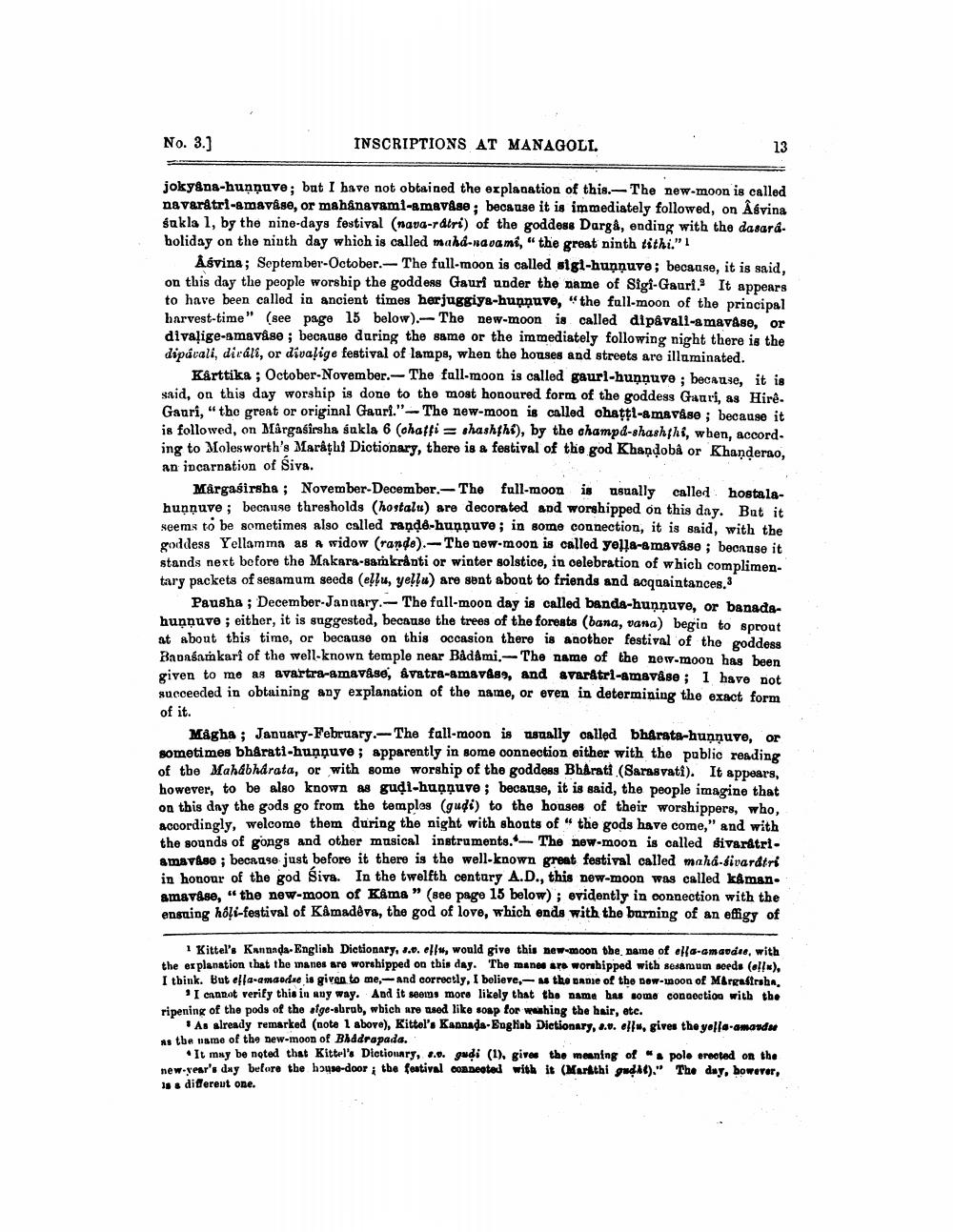________________
No. 3.)
INSCRIPTIONS AT MANAGOLI.
13
joky&na-huņņuve, but I have not obtained the explanation of this. The new-moon is called navaratrl-amavåse, or mahinavaml-emavise; because it is immediately followed, on Âgvina sukla 1, by the nine-days festival (nava-rdtri) of the goddess Dargå, ending with the dasard. boliday on the ninth day which is called mahd-ndvami," the great ninth tithi."
Asvina; September-October.- The full-moon is called sigt-huņņuve; because, it is said, on this day the people worship the goddess Gauri under the name of Sigi-Gauri. It appears to have been called in ancient times herjuggiys-huņņuve, "the full-moon of the principal harvest-time" (see page 15 below).- The new-moon is called dipävall-a mavase, or divalige-smavåge ; because during the same or the immediately following night there is the dipávali, dicáll, or divaļige festival of lamps, when the houses and streets are illuminated.
Kårttika ; October-November.-The full-moon is called gaurl-huņņuvo; because, it is said, on this day worship is done to the most honoured form of the goddess Gauri, as Hirê. Gauri," the great or original Gauri."-The new-moon is called chatti-amavågo; because it is followed, on Margasirsha sukla 6 (ohaffi = shashthi), by the champd-shashthi, when, accord. ing to Molesworth's Marathi Dictionary, there is a festival of the god Khandobâ or Khanderao, an incarnation of Siva.
Mårgaģirsha; November December. - The full-moon is usually called hostalahunnuve; because thresholds (hostals) are decorated and worshipped on this day. But it seems to be sometimes also called rand&-huņņuve; in some connection, it is said, with the goddess Yellamma as a widow (rando).-The new-moon is called yolla-a mavåse ; beorgse it stands next before the Makara-Bankranti or winter solstice, in celebration of which complimentary packets of sesamum seeds (elfu, yellu) are sent about to friends and acquaintances.3
Pausha ; December-January-The fall-moon day is called banda-hunnuve, or banadahunnuve; either, it is suggested, because the trees of the forests (bana, vana) begin to sprout at about this time, or because on this occasion there is another festival of the goddess Baongamkart of the well-known temple near Bådåmi.-The name of the now-moon has been given to mo as avartra-amavise, Avatra-am&vå89, and avaratrl-amsväse; I have not succeeded in obtaining any explanation of the name, or even in determining the exact form
of it.
MÅgha ; January February. The fall-moon is usually called bharata-hunnuve, or sometimes bhArati-huņņuve; apparently in some connection either with the public reading of the Mahabharata, or with some worship of the goddess Bharati (Sarasvati). It appears, however, to be also known as guļi-huņņuve; because, it is said, the people imagine that on this day the gods go from the temples (gudi) to the houses of their worshippers, who, accordingly, welcomo them during the night with shouts of the gods have come," and with the sounds of gongs and other musical instruments. The now-moon is called givaratri. AMAVANO ; becau90 just before it there is the well-known great festival called maha livardtri in honour of the god Siva. In the twelfth century A.D., this new-moon was called kaman. smavese, “the new-moon of Kåma” (see page 15 below); evidently in connection with the ensuing hôļi-festival of Kamadeva, the god of love, which ends with the burning of an effigy of
1 Kittel's Kannada-English Dictionary, 3.0. ellu, would give this new-moon the name of effa-amaodine, with the explanation that the manes are worshipped on this day. The mano ars worshipped with sesamum seeds (o!!*), I think. But ella-amaodne is given to me.- and correctly, I believe, - As the badle of the now-woon of Margafirshn.
I ennnot verify this in any way. And it seems more likely that the name has some connection with the ripening of the pods of the afge-sbrub, which are used like soap for wahing the hair, ate.
As already remarked (note 1 above), Kittel's Kannada-English Dictionary, 2.0. effu, gives the yolla.amanda As tbe name of the new-moon of Biddrapada.
It may be noted that Kittel's Dictionary, 8.0. gadi (1), gives the meaning of "s pole erected on the new year's day before the boyse-door tbe festival connected with it (Marathi gwd)." The day, however, 15. difereut one.




